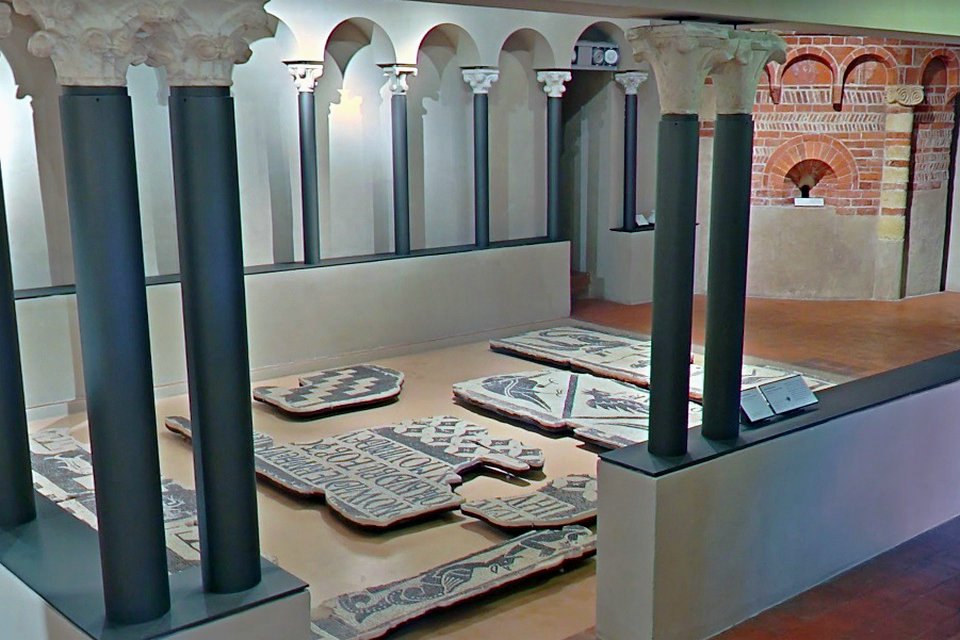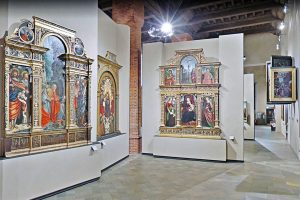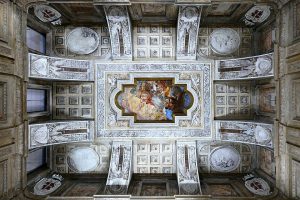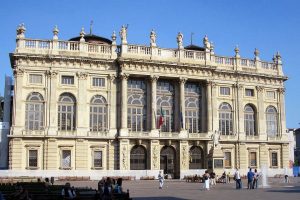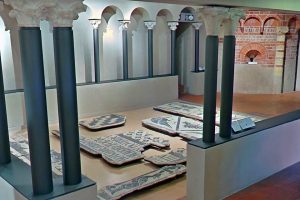In the basement of Madama Palace, at the level of the Roman foundations, there is the Medieval Lapidary, with stone sculptures and goldsmiths. Located in the heart of Turin, in what was to be the Roman Quadrilateral castrum, the complex stands on what, at the time of the ancient Roman colony of Julia Augusta Taurinorum, was called the Porta Praetoria (for other historians it was instead the Porta Decumana), from which the Decumanus Maximo was entered by entering from the eastern part. Here in fact you had access to the city from the side of the Po, which was carefully defended due to its strategic position; after the fall of the Western Roman Empire, the gate was transformed into a fortress, suitable for city defense, given the obvious importance of this route of communication, even if it maintained the original function of passage with the opening in the ancient Roman wall. Already in the ninth century the name of a second passage, called Fibellona, of uncertain etymology is confirmed.
The primitive fortification then passed to the Marquises of Monferrato in the thirteenth century, and this was the place where, in all likelihood, the treaty between William VII of Monferrato and Thomas III of Savoy was signed which provided for the release of the first and the transfer of Turin from the Aleramici to the Savoy. It was 1280.
The centuries went by and the fortification of Porta Decumana passed into the ownership of the Savoy-Acaja family (cadet branch of the Savoy family ) who enlarged it into a castle in the first half of the 14th century: this happened by natural dynastic descent, from Thomas III to Philip I, prince of Savoy and lord of Acaja, who has since exercised effective power over Turin, making this stronghold its center of power.
A century later it is always an Acaja, Lodovico, to rearrange the castle, making it assume the square shape with courtyard and portico, four angular cylindrical towers, still partially recognizable today on three sides. The extinction of the Acaja branch saw the castle become a residence for Savoy guests.
Timeline
Foundation of Building
1st century AD
The history of the building in the center of Piazza Castello begins in Roman times. One of the ancient entrances to the city of Augusta Taurinorum opened onto the foundations of today’s palace: it is the eastern gate, formed by two towers of sixteen sides, which framed four arched entrances, two central for the wagons and two lateral for pedestrians. Its dimensions and shape were similar to those of the Palatine Gate north of the city. On their way to the Library and the exit, visitors to the museum pass through the still visible remains of the Roman wall.
The unknown soldier
1st century AD
Among the Roman remains rediscovered by Alfredo d’Andrade during the nineteenth century excavation campaign, which brought to light the foundations of the door and some marble reliefs with military scenes, the crowning of a sepulchral memorial was also found, today in the museum. The unknown Roman soldier, for whom it was carved, wanted to represent the “Roman she-wolf” in the tympanum, a reminder of the distant homeland left to move to conquer the Empire.
The decline with the end of the Western empire
5th century
Palazzo Madama offers itself to our eyes like a compelling history book, not without unknown pages. From the end of the Western empire to the new millennium there is no news of the door; the excavations carried out confirm the suspicion of a decay of the structures and buildings of the guardhouse almost no traces remain, surely destroyed by the eighteenth-century foundation works of the current facade, which went to a much greater depth than the Roman level.
The early Middle Ages and the first communal age
4th-6th century
There are clearly legible signs of the construction of the Palace in the early Middle Ages, but we know that at the end of the XI century, in the already communal age, the control functions resumed at the gate and tax and that outside the walls it is necessary to build barracks. Evidence of this historical period can be found today in the underground areas of the Museum, once used as a warehouse: a nucleus of sculptures from the Piedmont area and a series of fragments, which document the furnishings of the ancient church of San Salvatore, a building existing on the site of the current Turin Cathedral.
The capitals of Sant’Orso
7th century
Among the most significant inventions of the Romanesque civilization, the historiated capitals transpose the great narrative themes of the Ancient and of the New Testament. A clear example of this are those coming from the cloister of the Sant’Orso di Aosta collection, evidence of great importance in the history of medieval sacred art and among the most precious pieces of the Lapidary of the Civic Museum.
“Arnaldus” and the “Maestro di Rivalta Torinese”
7th century
The activity of the artists active in Piedmont in the XII century is documented by the works exhibited on the moat floor of the museum. These include “Arnaldus”, who signs a fragment from Oulx in the Susa Valley, and the anonymous “Maestro di Rivalta Torinese”, also hired at the Sacra di San Michele and present on display with two figured capitals. The predilection of Romanesque sculptors for the figured scenes is expressed in works with different functions, such as the lunettes of the portals, the baptismal font, the holy water fonts, the reliefs intended for places of worship: different examples of these productions can be appreciated along the way inside the Medieval Lapidarium.
The mosaic of Acqui
1120-30
In the moat floor of the museum one of the most interesting mosaic creations of Piedmont is exhibited. Linked to the commission of Bishop Azzone, the work was found in 1854, during the works for the new flooring of Santa Maria di Acqui, and dated between the second and third decade of the twelfth century. The inscription mentions the great bishop Guido (Widone), thanks to whose stimulus the cathedral was built at the beginning of the year 1000. Currently the remains of the mosaic are made up of thirteen fragments with black and white marble blocks laid on the original pinkish mortar. The panels represent episodes that are still difficult to identify.
The formation of the castle and the Porta Fibellona
1225-60
In the Middle Ages the Roman gate underwent its first radical metamorphosis and from the threshold it became the defense of the city. The Roman arches were closed and a fort was erected close to the towers. Porta Fibellona is the name given to the new passage between the city and the countryside, opened in the ancient walls next to the southern tower and still partially visible inside the Palace, along the staircase leading to the moat floor. It is the only medieval gate in Turin that survived the expansion of the city: its round arch imitates the Roman model, inserting itself into a general phenomenon of rebirth and reuse of the ancient.
The first documents of the castle
1290-99
The maintenance works documented by the reports of the official Fredericus de Loyra attest to the existence of a defense structure, “castrum”, incorporated in the Roman gate. A decade earlier, the treaty of cession of the city that the Marquis Guglielmo di Monferrato was forced to stipulate with Tommaso di Savoia in 1280 already mentions it.
The castle is a military and diplomatic seat
1297
Prince Philip I elected Pinerolo as a privileged residence for the Achaia court and prefers to use the castle of Turin as a military and diplomatic seat rather than as a courteous residence. The documents recall, for example, the preparation of an expedition in Val San Martino: the prince supports the expansionist policy of his uncle Amedeo V and makes the fortified building available as a meeting point with the Piedmontese nobles.
The location outside the town
1298
In the documents of the end of the thirteenth century, where we find the “castrum porta Fibellone”, the noble power is now identified with the Castle of Turin, although this occupies a location on the edge of the town towards via Little.
Madama Palace
Palazzo Madama and Casaforte degli Acaja is an architectural and historical complex located in the central Piazza Castello in Turin. Having played a leading role in its history from Roman times through to the present day, it was declared a World Heritage Site with the other Residences of the House of Savoy in 1997. Palazzo Madama, as part of the Savoy Residences serial site. The building houses the Civic Museum of Ancient Art.
It is a combination of two thousand years of Turin ‘s history, from the ancient eastern gate of the Roman colony of Julia Augusta Taurinorum to a defensive stronghold, then to a real castle, a symbol of Savoy power until at least the sixteenth century, when the current Royal Palace, as the seat of the Duke of Savoy.
The western part of the first medieval complex was later called Palazzo Madama because it was first inhabited by Madama Cristina of Bourbon-France, called the “first Royal Madama”, in the period around 1620 – 1663, then fromMaria Giovanna Battista di Savoia-Nemours, called the “second Royal Madama”, in the period 1666 – 1724. It was for the latter that the current facade was designed, in 1716 – 1718, by the court architect Filippo Juvarra.
The visit covers four floors, where the centuries-old story of its construction interacts with the collections of the Museo Civico d’Arte Antica, which have been here since 1934.
The early centuries of the Middle Ages are illustrated in the Mediaeval Stonework Collection on the moat level, with its sculptures, mosaics, and jewellery dating from the Later Antique period to the Romanesque. The fifteenth-century rooms on the ground floor contain paintings, sculptures, miniatures and precious objects from the thirteenth to the sixteenth century, mainly from Piedmont. In the circular room in the Treasure Tower there is a selection of masterpieces, including the famous Portrait of a Man by Antonello da Messina. On the piano nobile, with its stunning array of Baroque stuccoes and frescoes, there is the modern picture gallery with works from the Savoy Collections and an important selection of furniture made by Piedmontese, Italian, and French master cabinetmakers. Lastly, the top floor houses the decorative arts collections, which are a key part of the museum’s assets, with majolica and porcelain, glasswork and ivories, fabrics and lace, jewellery and metals, as well as the stunning collection of gilded, painted and sgraffito glass, unrivalled in terms of its quantity and quality.
